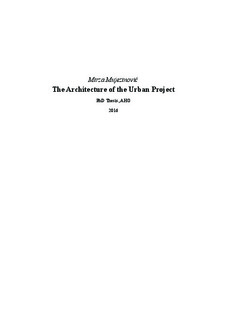The Architecture of the Urban Project
Doctoral thesis, Peer reviewed
Permanent lenke
http://hdl.handle.net/11250/2412710Utgivelsesdato
2016-10-04Metadata
Vis full innførselSammendrag
“The Architecture of the Urban Project” is about large-scale architecture in Norway. Projects that potentially fall into this category are those that blur the distinction between the city and the building, more specifically projects such as new universities, urban redevelopments and waterfront transformations.
Usually, such projects have one investor (either public or private) and consist of several building volumes developed in stages, where each stage is interdependent of the totality, being able to function both on its own and within the framework of the whole project.
The research addresses how large-scale architecture evolved from the late 1960s up to the early 1980s in Norway. From the societal perspective, this period represents shifting economic, political and technological realities. The post-war reconstruction had ended; the process of modernization had made itself increasingly present, and the process of democratization had become gradually more absorbed within the framework of decision-making, especially within the planning and building sector with the new building law of 1965. From the architecture culture perspective, it is the period of critique of modernism, representing the emergence of interest for the traditional (European) city as explicated through the processes of revitalization and densification. Working within and learning from the existing urban context would emerge both as a constraint and as a source of inspiration for practicing architects. The research revolves around the question: to what degree does a specific type of architectural and urbanistic sensibility emerge due to the changing societal condition and its subsequent (large-scale) building assignments in the above-mentioned period? The notion of sensibility refers to interplay between a general architectural and urbanistic discourse on one side, and architects’ ability both to comprehend complexities around and within building assignments, and to translate these complexities into physical structures, on the other side.
The primary source for this study is large-scale projects in Norway: Henning Larsen’s University of Trondheim, Platou’s Vaterland and Telje-TorpAasen’s Aker Brygge. In other words, this research is a monograph about one particular type of projects within one specific period.
